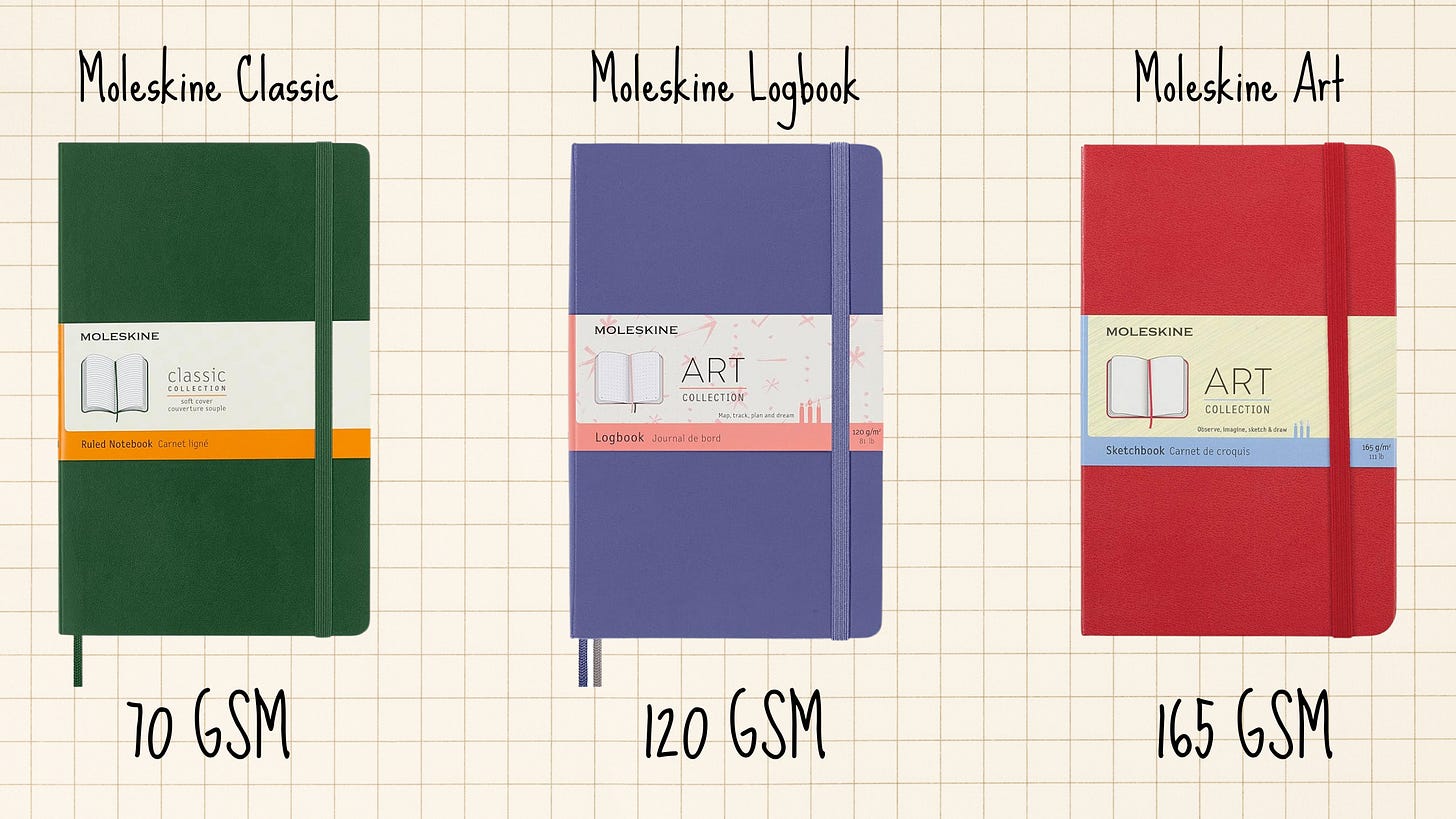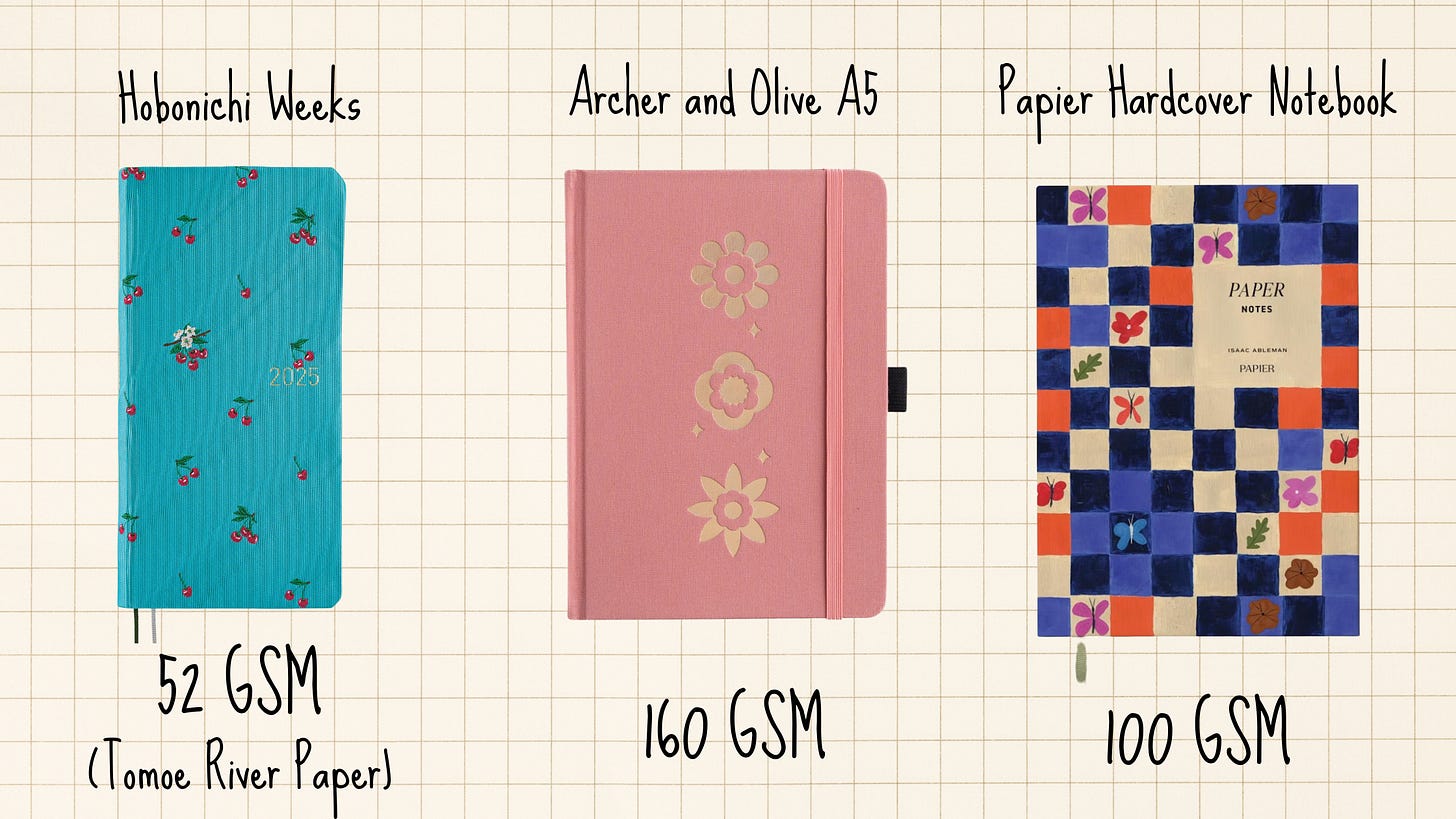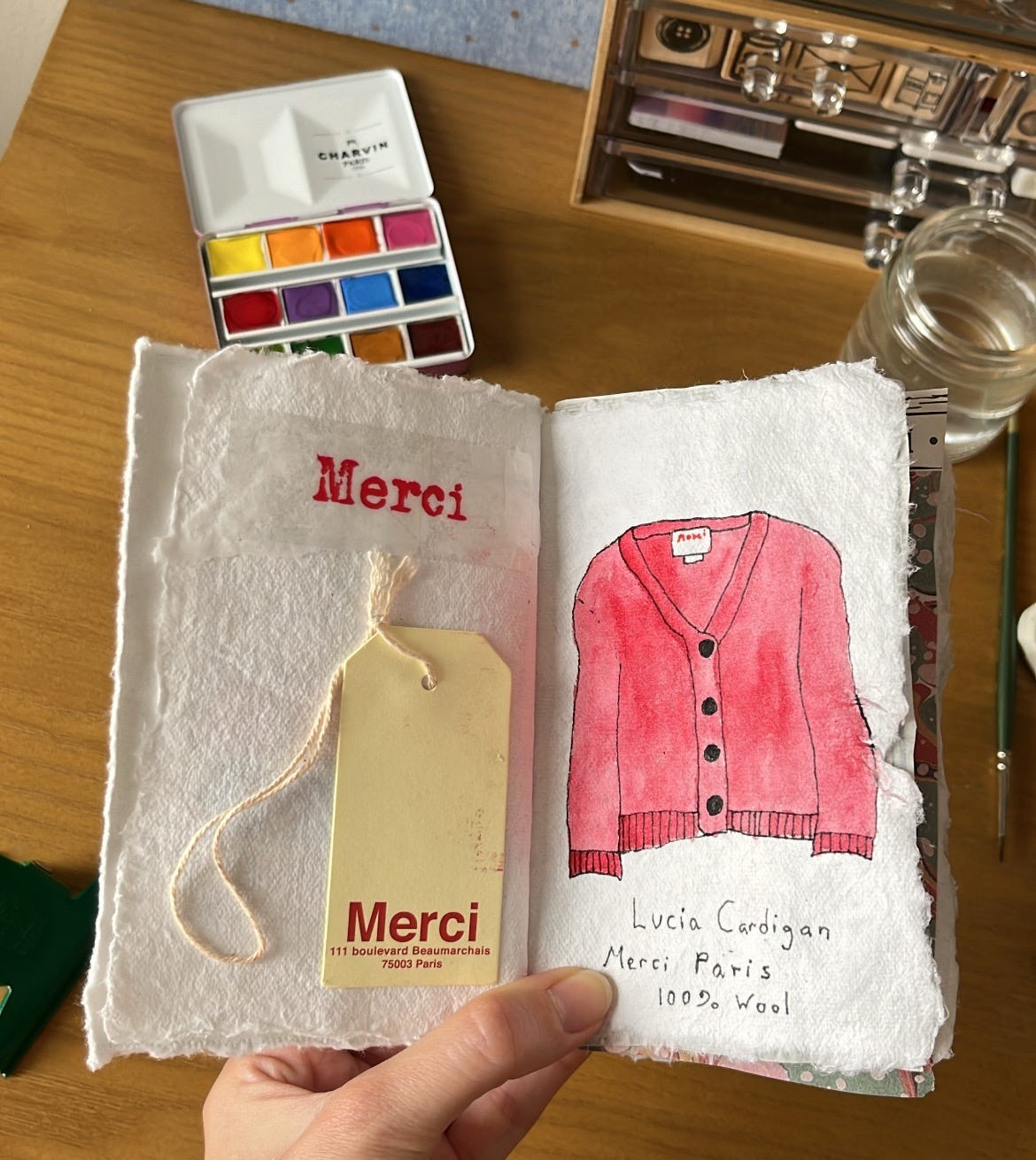**This post was originally published in August of 2024 under the title “The Paper Weight Resource”, this 2025 version is new and improved.
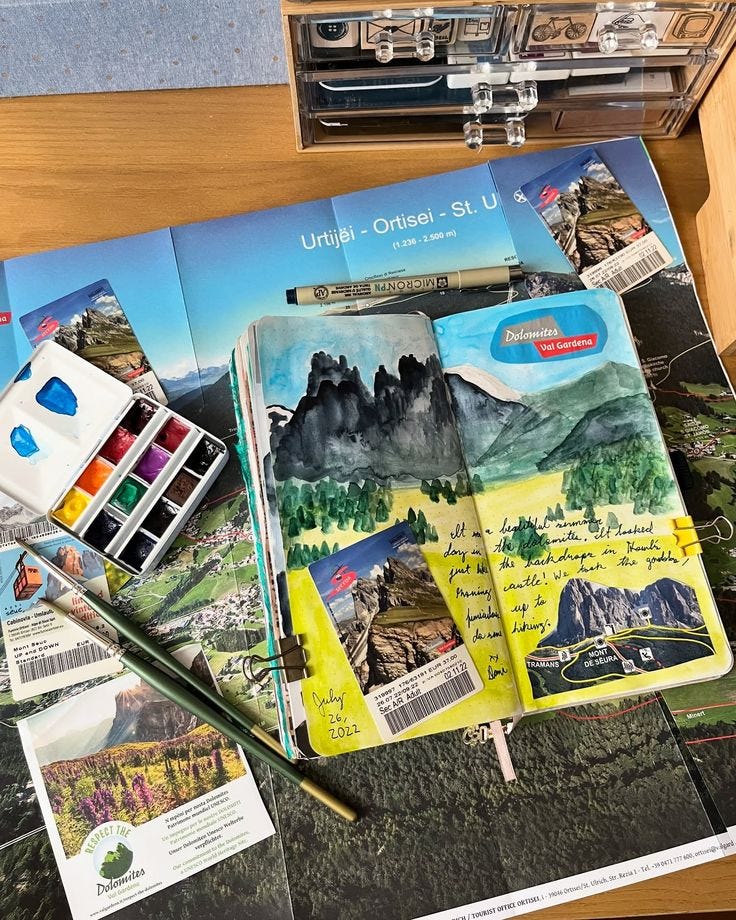
Choosing the Best Notebook for You
is all about finding the paper that best suits your needs. Let’s talk Paper Weight. First, an informational video by me: (The same video can also be found on Reels here).
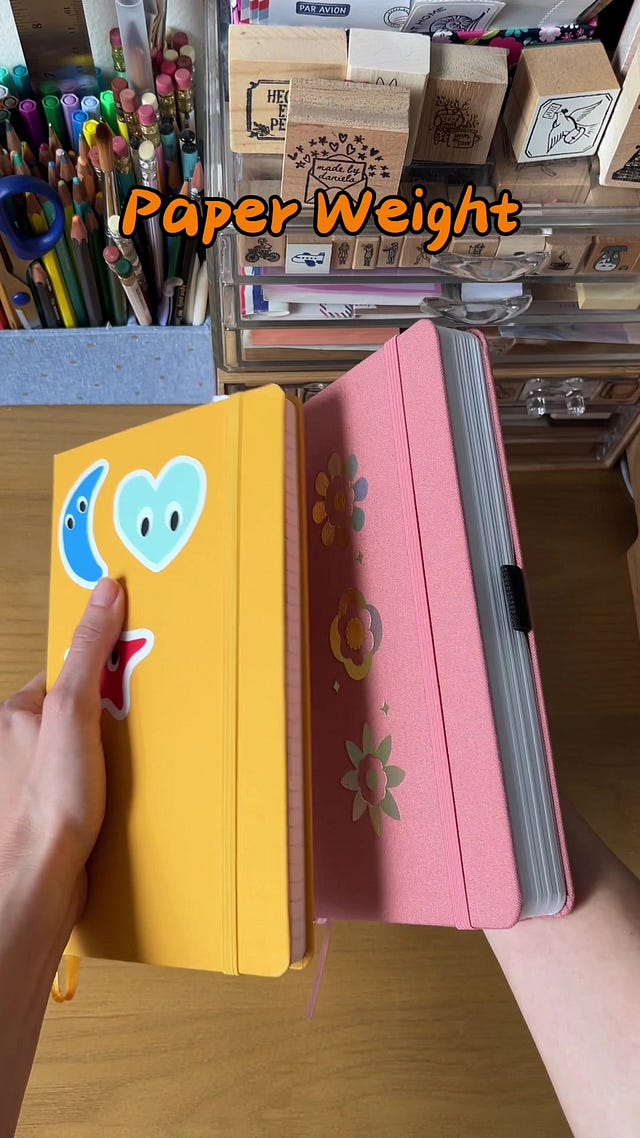
 Tiktok failed to load.
Tiktok failed to load.Enable 3rd party cookies or use another browser
What is Paper Weight?
Paper Weight (paper thickness) in notebooks is commonly1 measured in GSM: Grams per Square Meter. The GSM of a notebook is like the horsepower of a car’s engine, and if you’re serious about paper quality, should be the first thing you look for when you’re notebook shopping. The higher the number, the thicker and sturdier (more powerful) the paper. Do you need something that can tow a boat, or a low-key vehicle for a daily commute? Are you using watercolor and fountain pen ink in your journal, or mostly stickers and gel pens? Different GSMs suit different needs!
**Paper composition/type also affects the absorbency greatly, but for brevity, I will not be addressing that here, as this is a Substack post and not a masterclass on paper. GSM info only beyond this point. 📓
Not all Moleskines are created equal. Exhibit A:
Stationery posers make blanket statements like “[popular brand] has thin paper,” real stationery heads know that brands often offer different GSMs for different use cases. 😤😤😤 GSM varies by notebook model, not brand. In Exhibit A, we’ll examine three notebook models from same brand, Moleskine:
The Moleskine Classic (70gsm): a lined notebook with very thin paper meant for writing, and notetaking. Because of its thin paper, more pages fit into the notebook (192), while maintaining its signature slim profile.
The Moleskine Logbook (120gsm): is a dot grid notebook meant for Bullet Journaling. Because Bullet Journalers tend to use markers, highlighters, etc. the paper is slightly thicker, with a lower page count (160) to compensate for the extra heft of the pages.
The Moleskine Art Sketchbook (165gsm): sports blank paper at a whopping 165gsm, meant to withstand paint, alcohol markers, inks, and any other materials artists might use. This notebook has the lowest page count of the three, at just 104 pages, to compensate for the GSM of the paper.
Not all Leuchtturms are created equal. Exhibit B:
How to find a notebook’s GSM:
The GSM of a notebook’s paper can usually be found on the notebook label, or near the price tag. When shopping online, GSM should be listed under the product details/specs. If you’re shopping for notebooks and there is no GSM listed, it’s usually a bad sign, unless you’re just using it for grocery lists, it’s totally fine! But if you plan on using any art supplies or fountain pens and there is no GSM listed, it’s a no-go.
GSM ranges and their use-cases:
A low GSM does not indicate low quality, but rather, a different use case. If you use a notebook mainly for writing with a ballpoint pen, or sketching with a pencil, you don’t need a high GSM, and you’ll get a lot more mileage out of a notebook with more pages rather than ultra-thick paper.
70-100gsm
Best for writing with dry mediums that do not release a lot of pigment. EG: Pencils, gel pens, fine tip pens, ballpoint pens.
Best for writers!
Typically marketed as journals, or diaries. Planners also tend to be in this GSM range.
Thin paper = more pages in the notebook. More mileage for writing/notetaking.
Lightweight for travel!
120-165gsm
Best for multimedia/art supplies that release a lot of wet pigment. EG: Fountain pens, light watercolor or gouache, markers, and inks.
Best for artists/multimedia journalers.
Typically marketed as sketchbooks.
Thicker paper = glue will not wrinkle the pages as easily. Better for junk journaling.
Can get heavy, especially if over 150 pages. (My current 160gsm notebook weighs over a pound.)
FAQ: Why is my notebook paper ghosting or bleeding!?!?
First, a definition of the terms:
Ghosting in a notebook refers to the issue of markings on one side of a page being visible from other side of the paper. Turning to the next page in the notebook doesn't feel like a "new" page when you can see the shadow of the markings on the other side. This can be frustrating as it can cause a page to look messy, or at worst, illegible. Ghosting can and will happen when lighter paper weights combined with heavy, wet, mediums.
Bleeding in the stationery world refers to the issue of pigment seeping through the page to the other side, rendering the other side of the page in that spot useless. This is especially frustrating because it defeats the purpose of the notebook. Both sides of each page should be usable! This happens when you're using a medium that's too heavy for the paper to absorb or withstand.
In short: It’s a paper problem! You’re using the wrong type of paper for your medium. As my watercolor teacher once said, you can get away with cheap paint, but you can’t skimp on the watercolor paper. You need a solid foundation to hold up your work!
And the winner is…..
Actually, there is no one-size-fits all solution when searching for the perfect notebook. Some value lightweight materials over anything else, and don't mind some ghosting as long as the notebook doesn't weigh a pound, (yes my A&O bullet journal currently weighs more than a pound🥲. 160gsm across 192 pages + a hard cover adds up!) Some junk journalers rarely allow ink to touch the page, adding layers upon layers of ephemera until the spine gives out (RIP notebook); GSM doesn’t technically matter for this particular journaling style, but sketchbooks tend2 to be more forgiving.
It is important to note that paper of any GSM will eventually reach its limit and bleed through if you try hard enough. There is no invincible paper type (when we’re talking notebooks), and if you’re using materials to that degree, perhaps your needs are better suited for a spiral bound sketchbook or notepad with ultra-thick multi-media paper. Cost ≠ higher GSM. I love buying student grade sketchbooks to use for journaling, like Talens notebooks, which have blank 140gsm paper, the classic elastic band, and are currently $15USD or below.
There are always exceptions to the rule. Paper composition/type will greatly affect absorbency and the types of mediums a notebook can withstand. Hobonichi notebooks have ultra-thin, 52gsm paper that can still hold fountain pen ink3, made possible by the legendary Tomoe River Paper and its special coating. Lamali notebooks have relatively thin pages, yet they’re made of 100% cotton (like the best watercolor paper), making them highly absorbent, highly textured, and great for watercolors or inks.
Your perfect notebook will likely be found via a journey of trial and error - but you don't have to go in completely blind, I made a table!
I present to you the notebook matrix: A Notion Table**
**A note on notebooks: This table lists notebooks only, which I am defining as hardbound books, around A5 size, with at least 100 pages. Spiral bound sketchbooks, or watercolor pads for example, will not be found on this list.
***Again, paper weight varies by notebook model, not brand. Always check the GSM on the label/listing!
Who offers the highest page count at the lowest price? The thickest dot grid paper available?
Keep reading with a 7-day free trial
Subscribe to Journaling Dan to keep reading this post and get 7 days of free access to the full post archives.





